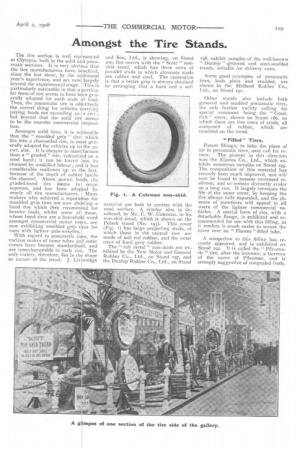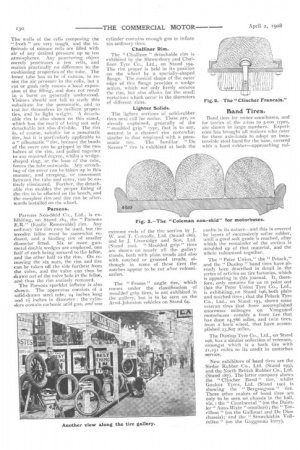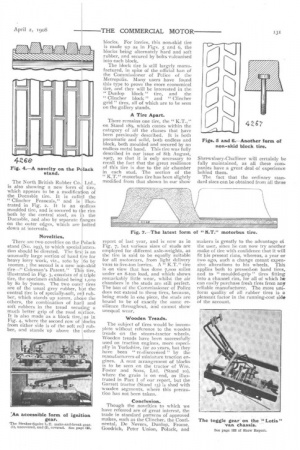Amongst the Tire Stands.
Page 39

Page 40

Page 41

If you've noticed an error in this article please click here to report it so we can fix it.
The tire section is well rep -esented at Olympia, both in the solid ard pneumatic sections. It is very obvious that the tire manufacturers have benefited, since the last show, by the acditional year's experience, and are now largely beyond the experimental stage. This is particularly noticeable in that a particular form of tire seems to have be en g-enorally adopted for each scale of load. Thus, the pneumatic tire is admitteoly the correct thing for vehicles carrying paying loads not exceeding 1O-2 cwt., but beyond that the solid fire seems to be the sounder commercial Proposition.
Amongst solid tires, it is nc:ticeable that the " moulded grip'' tire which fits into a channelled rim, is most g-enerally adopted for vehicles up to the 30cwt. size. It is cheaper to manufacture than a " graded" tire, vulcanised on a steel band; it can be forced nto its channel by unskilled labour ; ani it has considerable resilience up to the last, because of the depth of rubber inside the channel. Above 30-cwt. lo ds, the graded-band tire seems to reign supreme, and has been adopted by nearly all tire manufacturers. Many makers who achieved a reputaiion for moulded grip tires are now showing a band tire which they recommend for heavier loads, whilst some of those, whose band tires are a household word amongst commercial motor users, are now exhibiting moulded grip f res for vans with lighter axle-weights.
With regard to pneumatic fixes, the various makes of inner tubes and outer covers have become standardised, and are interchangeable in each size. The only variety, therefore, lies in the shape or nature of the tread. J. Liv.n-sidge
and Son, Ltd., is showing, on Stand 200, tire covers with the " Scott " nonskid tread, which has three rows of parallel studs in which alternate studs are rubber and steel, The contention is that a better grip is always obtained by arranging that a hard and a soft material are both in contact with the road surface. A similar idea is developed, by Mr. E. W. Coleman, in his non-skid tread, which is shown on the Polack stand (No. 193). This cover (Fig. 1) has large projecting studs, of which those in the central row arc made of soft red rubber, and the outer rows of hard grey rubber.
The " rub metal " non-skids are exhibited by the New Motor and General Rubber Co., Ltd., on Stand r97, and the Dunlop Rubber Co., Ltd., on Stand 198, exhibit samples of the well-known " Dunlop " grooved and steel-studded treads, suitable for delivery vans.
Some good examples of pneumatic tires, both plain and studded, are shown by the Midland Rubber Co., Ltd., on Stand 191.
Other stands also include both grooved and studded pneumatic tires, the only further variety calling for special comment being the " Goodrich " cover, shown on Stand 186, on which there are five rows of studs, all composed of rubber, which are moulded on the tread.
"Filled" Tires.
Patent fillings, to take the place of air in pneumatic tires, next call for review. The pioneer in this direction was the Elastes Co., Ltd., which exhibits numerous samples on Stand 195_ The composition of this material has recently been much improved, and will now be found to possess increased resilence, and to remain distinctly cooler on a long run. It largely increases the life of the outer cover, by keeping the tire always fully expanded, and the absence of punctures will appeal to all users of the lighter commercial vehicles. A special form of rim, with a detachable flange, is exhibited and recommended for use with this filling, as it renders it much easier to secure the cover over an " Elastes "-filled tube.
A competitor to this filling has recently appeared, and is exhibited on Stand 192. It is called the " Plicumatic "tire, after the inventor, a German of the name of Pfleumer, and is strongly suggestive of congealed froth.
The walls of the cells composing the " froth " are very tough, and the infinitude of minute cells are filled with air of any desired pressure up to ten atmospheres. Any puncturing object merely penetrates a few cells, and makes practically no difference to the cushioning properties of the tube. The inner tube has to be of canvas, to resist the air pressure in the cells, but a cut or gash only causes a local expansion of the filling, and does not result ill a burst as generally understood. Visitors should not fail to study this substitute for the pneumatic, and to test for themselves its resilient properties, and its light weight. A detachable rim is also shown on this stand, which has the merit of being not only detachable but also divisible. The rim is, of course, suitable for a pneumatic tire, but it is particularly applicable to a " pfleumatic " tire, because the beads of the cover can be gripped by the two halves of the rim, and pulled together to any required degree, whilst a wedgeshaped ring, at the base of the tube, forces the tube outwards, Any stretching of the cover can be taken up in this manner, and creeping, or movement between the tube and cover, can be entirely eliminated, Further, the detachable rim enables the proper fitting of the tire to be effected on the bench, and the complete rim and tire can be after-wards installed on the wheel.
Parsons.
Parsons Non-Skid Co., Ltd., is exhibiting, on Stand 184, the " Parsons E.R." (Easily Removable) rim. Any ordinary tire rim rnay be used, but the wooden felloe must be somewhat reduced, and a binding tire of smaller diameter fitted. Six or more gunmetal double wedges are employed, one half of each being secured to the felloe, and the other half to the rim. On removing the six nuts, the rim and tire can be taken off the side furthest from the valve, and the valve can then be drawn out of the valve hole in the felloe, and thus the rim entirely removed.
The Parsons sparkiet inflator is also shown. The apparatus consists of a solid-drawn Steel tube, 24 inches long and 2f inches in diameter the cylinders contain carbonic acid gas, and one cylinder contains enough gas to inflate ten ordinary tires.
Challiner Rim.
The " Challiner " detachable rim is exhibited by the Shrewsbury and Chatliner Tyre Co,, Ltd., on Stand 394. The rim proper is held in its position on the wheel by a specially-shaped flange. The conical shape of the outer edge of this flange provides a wedge action, which not only firmly secures the rim, but also allows for the small variations which occur in the diameters of different rims.
Lighter Solids.
The lighter sections of solid-rubber tires next call for notice. These are, as already explained, generally of the " moulded grip " type, that is to say, secured in a channel rim somewhat similar to that employed with a pneu matic tire. The familiar " De Nevers " tire is exhibited at both the extreme ends of the tire section by J. W. and T. Connolly, Ltd. (Stand 186), and by J. Liversidge arid Son, Ltd. (Stand 200). " Moulded grip " tires are shown on nearly all the gallery stands, both with plain treads and also with notched or grooved treads, although in some of these tires the notches appear to be cut after vulcanisation.
The " Frame " angle tire, which comes under the classification of moulded grip tires, is not exhibited in the gallery; but is to be seen on the Arrol-Johnston vehicles on Stand 64.
Rand Tires.
Band tires for motor omnibuses, and for lorries of the 2-ton to 5-ton types, are shown in large numbers. Experience has brought all makers who cater for these axle-loads to adopt an inextensible steel band for the base, covered with a hard rubber—approaching vul canite in its nature—and this is covered by layers of successively softer rubber, until a good soft grade is reached, after which the remainder of the section is moulded up of that material, and the whole vulcanised together.
The " Peter Union," the " Polack," and the " Dunlop" band tires have already been described in detail in the series of articles on tire factories, which is appearing in this journal. It, therefore, only remains for us to point out that the Peter Union Tyre Co., Ltd., is exhibiting, on Stand 196, both plain and notched tires ; that the Polack Tyre Co., Ltd., on Stand 193, shows some veteran tires that have accomplished enormous mileages on Vanguard motorbuses—notably a front tire that has done 24,786 miles, and twin tires, from a back wheel, that have accomplished 23,807 miles.
The Dunlop Tyre Co., Ltd., on Stand 198, has a similar collection of veterans, amongst which is a back tire with 21,251 miles to its credit in motorbus service.
New exhibitors of band tires are the Sirdar Rubber Co., Ltd, (Stand 199), and the North British Rubber Co., Ltd. (Stand 187). The latter company shows the "Clincher Band " tire, whilst Gaulois Tyres, Ltd. (Stand 190) is showing the " Bergougnan " tire. Three other makes of band tires are only to be seen on chassis in the hall, viz. : the" Continental "(on the Daimler" Auto-Mixte "omnibus); the " Torrilhon '' (on the Gallinari and De Dion chassis); and the " Stroeckichis Vollreifen " on the Gaggenau lorry).
The North British Rubber Co: Ltd., is also showing a new form of tire, which appears to be a modification of the Ducasble tire. It is called the " Clincher Francais," and is illustrated in Fig. 2. It is an endless moulded tire, and is secured to the rim both by the central steel, as ii the Ducasble, and also by separateflanges on the outer edges, which are bolted down at intervals.
Novelties.
There are two novelties on the Polack stand (No. 193), to which special attention should be directed. The firs: is an unusually large section of band t re for heavy lorry work, viz., 1o6o by -,6o by toomm. ; the second is a new non-skid tire—" Coleman's Patent." This tire, illustrated in Fig. 3, consists of a triple tire, the specimen exhibited being I,GIO by 8o by 7omin. The two oute:tires are of the usual grey rubber, b It the central tire is of specially-soft, red rubber, which stands up lornm. above the others, the combination of hard and soft rubbers in the tread secuting a much better grip of the road a. rface. It is also made as a block tire, as in Fig. 4, where the second row of plocks from either side is of the soft red rubber, and stands up above the other
blocks. For lorries, this non-skid tire is made up as in Figs. 5 and 6, the blocks being alternately hard and soft rubber, and secured by bolts vulcanised into each block.
The block tire is still largely manufactured, in spite of the official ban of the Commissioner of Police of the Metropolis. Many users have found this type to prove the more economical tire, and they will be interested in the " Dunlop block " tire, and the " Clincher block " and " Clincher grid " tires, all of which are to be seen on the gallery stands.
A Tire Apart.
There remains one tire, the " K.T.," on Stand 189, which comes within the category of all the classes that have been previously described. It is both pneumatic and solid, both endless arid block, both moulded and secured by an endless metal band. This tire was fully described in our issue of 8th August, 1907, so that it is only necessary to recall the fact that the great resilience of this tire is due to the air chamber in each stud. The section of the " K.T." motorbus tire has been slightly modified from that shown in our show report of last year, and is now as in Fig. 7, but various sizes of studs are employed for different axle-weights, as the tire is said to be equally suitable for all motorcars, from light delivery vans to five-ton lorries. A " K.T." tire is on view that has done 7,000 miles under an 8-ton load, and which shows remarkably little wear, whilst the air chambers in the studs are still perfect. The ban of the Commissioner of Police does not extend to these tires, because, being made in one piece, the studs are bound to be of exactly the same resilience throughout, and cannot show unequal wear.
Wooden Treads.
The subject of tires would be incomplete without reference to the wooden treads on the steam-tractor wheels. Wooden treads have been successfully used on traction engines, more especially in Yorkshire, for 20 years, but they have been " re-discovered " by the manufacturers of miniature traction engines. A neat arrangement of blocks is to be seen on the tractor of Wm. Foster and Sons, Ltd. (Stand where the grain is on end, as illustrated in Part I of our report, but the Garrett tractor (Stand 13) is shod with wooden segments, where this precaution has not been taken.
Conclusion.
Though the .novelties to which we have referred are of great interest, the trade in standard patterns of approved makes, such as the Clincher, the Continental, De NeVers, Dunlop, Frome, Goodrich, Peter Union, Polack, and
Shrewsbury-Challiner will certainly be fully maintained, as all these companies have a great deal of experience behind them.
The fact that the ordinary standard sizes can be obtained front all these makers is greatly to the advantage oi the user, since he can now try another make of tire with confidence that it will fit his present rims, whereas, a year or two ago, such a change meant expensive alterations to his wheels. This applies both to pressed-on band tires, and to " moulded-grip " tires fitting into a channel rim, for all of which he can easily purchase fresh tires from any reliable manufacturer. The more uniform quality of all rubber tires is a pleasant factor in the running-cost side of the account.




























































